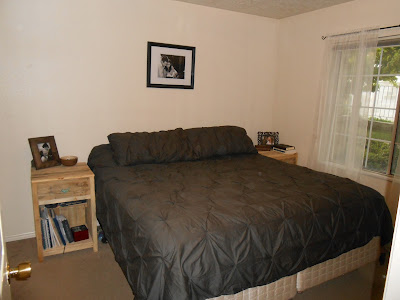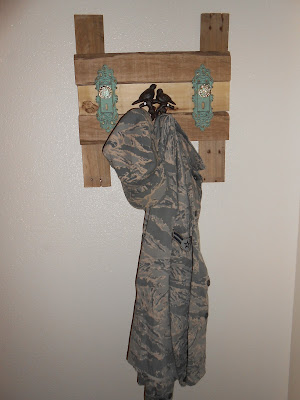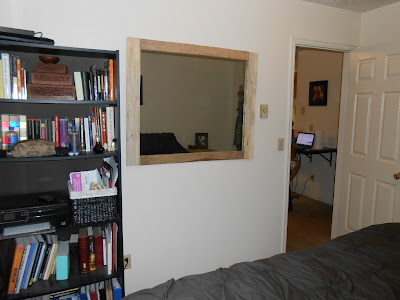We also spent a fair amount of time driving around desperately trying to find button forms for the tufting...we went to an upholstery store, Joann's, Michael's, you name it. No one seemed to have them, though everyone said everyone else would. We gave up and decided to reuse the old ones. More on that later.
I went to the fabric store thinking I wanted a solid dusky rose color...something to add some very subtle color. I did not get it--I fell head over heels for this instead:
We came home and got to work...cutting the foam, shaping it, drilling holes in it for the tufts. Our method was pretty much look how the original was done and mimic it any way you can.
The buttons were a challenge. I assigned Chris the job of separating the original forms (tough one, because they are only meant to be used once, and aren't made to come apart.) We tried for a while to cover them the way you normally would, but quickly realized that it wouldn't work with used forms. So, I cut big circles of fabric, wrapped them around the forms, and tied them with a piece of thread. (Normally, you would push the fabric into the inner circle of the form, which would clamp it in place. Doesn't work when you've taken apart the original form and it's lost its shape.)
It was pretty tedious work, but once it was done, the tufting was actually really fun. The challenge with tufting is to get the fabric positioned the way you want it. I made it simple by pulling it as tight as I could, adjusting the wrinkles, and pushing the button as far into the foam as it would go...it kept it pretty consistent.
I had cut the foam to size by laying the old foam over the new and tracing it out. We did something similar with the holes--just drilled through the existing holes in the foam into the new foam. It kept it simple by eliminating all the measuring we would normally do. Then we just laid the fabric over the new foam and pulled the excess fabric towards the bottom, since we started tufting at the top. (You need more fabric than you think you do, the tufting takes up quite a bit.)
When we were done, we stapled the foam to the chair frame. Here is where all those photos we took while taking it apart came in handy--we knew to wrap the foam over the back of the chair and staple it down, and pull it down and between the back and seat. We only stapled the top, because the fabric, once pulled tight and stapled in place, holds the foam where it needs to be. We didn't staple any foam for the seat, since the fabric pulled through on all sides and we could staple it down.
OH! And I forgot to mention that we restructured the seat and the springs. Chris got some rope and bound the springs in place, and we screwed some boards in about 5 inches beneath the springs to make the chair more stable, and make sure the springs didn't sag down too far. We also added a layer of foam and batting underneath the springs, but on top of the boards. The original chair didn't have this, and I think it makes the chair more stable and more comfortable. Our saggy seat is gone forever, now we have a firm, but comfortable, chair to sit in.
After a full day's work, and making a MESS of our living room (No joke, Chris didn't even bother to go outside to saw through those boards--it was such a mess a little sawdust made no difference), we were exhausted, but we had finished the biggest part of the chair. Here's how it looks now:
It looks absolutely fantastic. I can't wait to do the arms and wings, and put the final pieces on the back and sides...but I need to find someone to borrow a sewing machine from first, so I can do the piping. And I need to make a decision about the chair legs...I planned initially on painting them white, but now I'm not doing the rose chair anymore, and this fabric has a lot of white in it, so the original brown legs don't look too bad. I think I may just sand them down and put a fresh coat of dark stain on them.
We are planning on finishing this in the next few days...Chris is building a custom window seat for my sister Ruth, and we want to have this out of the way by then. Plus, Ruth was with me when I got this chair, and she got one herself:
It feels a little Dolores Umbridge-esque to me, but I think she is planning on replacing the hot pink with a subtle floral. Anyway, I promised to reupholster it with her, so I think that will occupy me while Chris is framing the window seat.
I promise to blog again by Wednesday. Have a great week everyone!
..and some advice from Chris: get your sleep while you can!
...he falls asleep so fast lately...probably because I have him up till 1 pulling out staples. That's true love right there.





















